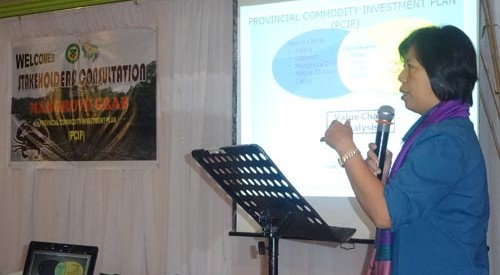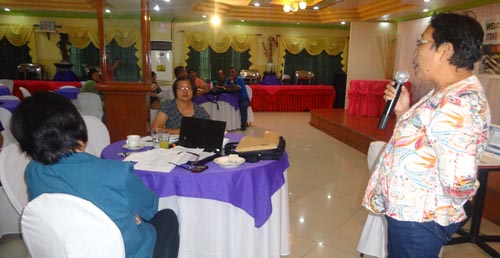
Catanduanes partners with PRDP towards becoming PH’s Crab Capital
September 10, 2015
One of the disadvantages of being in an isolated location is being left behind in the development and economic growth. This is how the island province of Catanduanes describes its development situation and challenges in its enhanced 2007 to 2013 Provincial Development and Physical Framework Plan.
Catanduanes is known as the “Land of the Howling Winds” because it lies within the typhoons’ path. This discourages tourists and entrepreneurs to visit or invest in the province. With the Philippine Rural Development Project’s (PRDP) initiatives to explore the island’s resources and potentials, Catanduanes will soon benefit from development projects that progressive provinces enjoy.
The Provincial Project Management and Implementation Unit (PPMIU) of Catanduanes is working closely with the Department of Agriculture’s PRDP Regional Project Coordination Office (RPCO) V in preparing the Provincial Commodity Investment Plan (PCIP) on mangrove crabs. The PCIP is a three-year rolling consensus plan between the DA and the local government unit that contains specific infrastructure and enterprise sub-projects and other interventions to boost the identified provincial commodity based on the value chain analysis (VCA) conducted with stakeholders.
Provincial Agriculturist Roberto Ceballo sees the PRDP as an opportunity to develop Catanduanes as the country’s Crab Capital. At the PCIP Stakeholders’ Consultation on the Mangrove Crab held on September 16, 2015 at Rakdell Inn in Virac, Catanduanes, Ceballo said that developing the mangrove crab industry will help raise the income of crab gatherers, stockers and fishpond owners in Catanduanes. He added that an integrated crab sanctuary will help promote eco-tourism in the province.
Catanduanes has a total of 589 hectares of fishponds. The 2012 summary of sold crablets and LGU income from shipping permits shows that the PLGU earned P386,950 from shipping permits for a total of 399,650 pieces of crablets shipped out of the province. Meanwhile, total estimated gross income from sales of crablets in 2012 was recorded at P2,553,150. Hence, the PCIP on the mangrove crab aims to establish a sustainable supply of crablets by protecting the spawning ground, protect the mangrove areas and other fishing grounds where crablets grow, and introduce new production technologies for crab growing and fattening. The PCIP on the mangrove crab also intends to improve existing producers’ productive capacity and competitiveness and develop the market for crabs.
“The PCIP belongs to the province. We are here to assist you in preparing a workable plan to achieve your goal of becoming the Crab Capital of the Philippines,” PRDP RPCO V Planning Specialist Mary Ann R. Cuya said.
The PCIP Stakeholders’ Consultation was attended by fishpond operators as well as representatives from various government agencies including the Bureau of Fisheries and Aquatic Resources, Department of Labor and Employment, Department of Trade and Industry, Department of Social Welfare and Development, and members of the PPMIU-Catanduanes. Provincial Board Member and Committee on Agriculture Chairman Jorge C. Reyes also attended the activity.
Among the issues and concerns discussed during the consultation were unprotected spawning or breeding grounds for mangrove crabs, unabated collection of crablets, and unstable price of crablets. To address these concerns, the stakeholders agreed to declare Panay Island as a Marine Protected Area, strictly enforce fishery laws, rules and ordinances, and establish a Crab Buying and Marketing Center. In addition, a “Task Force Kinis,” in charge of preventing illegal fishing and collection of crablets, will be created through an Executive Order. Meanwhile, declaring November to March as closed season on gathering or harvesting crablets was proposed. Moreover, the need for the reforestation of mangrove areas in Pandan, Bagamanoc, and Panganiban was cited.
PPMIU member Nelia B. Teves expressed hope that the PCIP stakeholders’ consultation will mark the beginning of collaborative efforts among DA, PRDP, government agencies, and private sector to realize the plan of integrating progress towards mangrove crab industry.
Furthermore, she sought the stakeholders’ full support and cooperation towards a successful PRDP undertaking in Catanduanes and improved quality of lives of Catandunganons.
On July 31, 2015, PPMIU-Catanduanes’ proposed Abaca Fiber Processing and Trading Center, a P24,773,220-worth business plan for its first priority commodity–the abaca was approved by the Regional Project Advisory Board and is waiting No Objection Letter 1 issuance to avail of PRDP funding.
PRDP is a six-year project designed to raise incomes, productivity, and competitiveness in the countryside by establishing an inclusive, climate-smart and market-oriented agri-fishery sector. In partnership with LGUs and the private sector, the PRDP will provide key infrastructure, facilities, technology, and information using science-based tools such as Vulnerability and Suitability Assessment (VSA), Expanded VSA (e-VSA), VCA, geomapping and geotagging. (Annielyn L. Baleza, I-SUPPORT InfoACE Unit, DA-RAFIS 5)

PPMIU member Nelia B. Teves calls for the stakeholders’ full support and cooperation towards a successful PRDP undertaking in Catanduanes during the PCIP Stakeholders’ Consultation on the Mangrove Crab held on September 16, 2015 at Rakdell Inn in Virac, Catanduanes.

